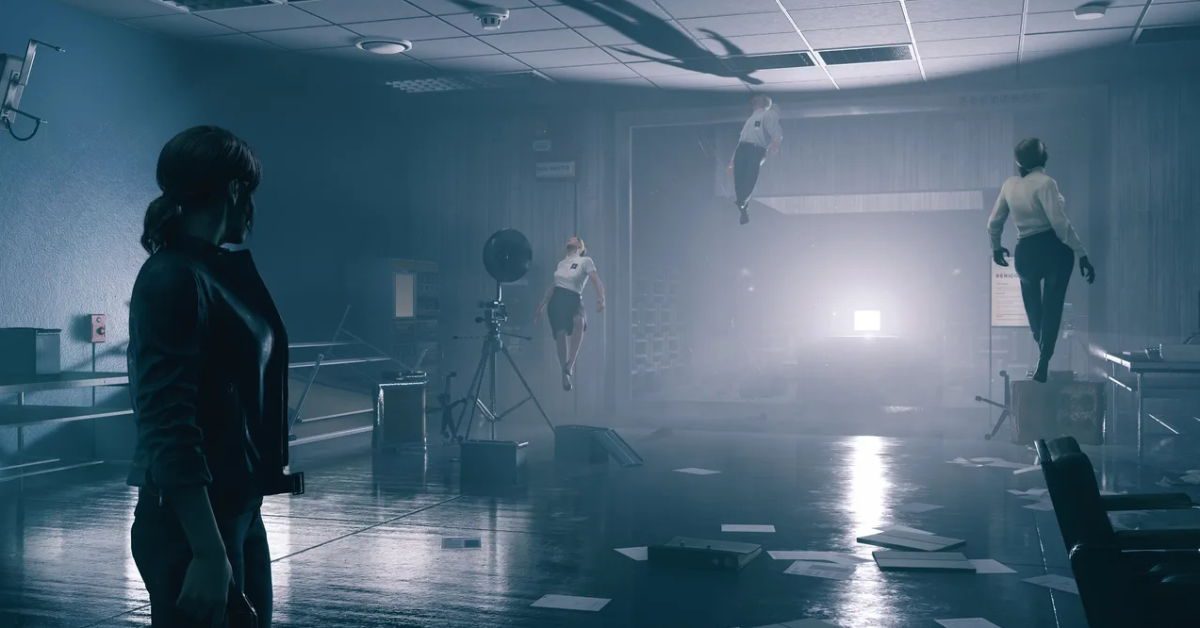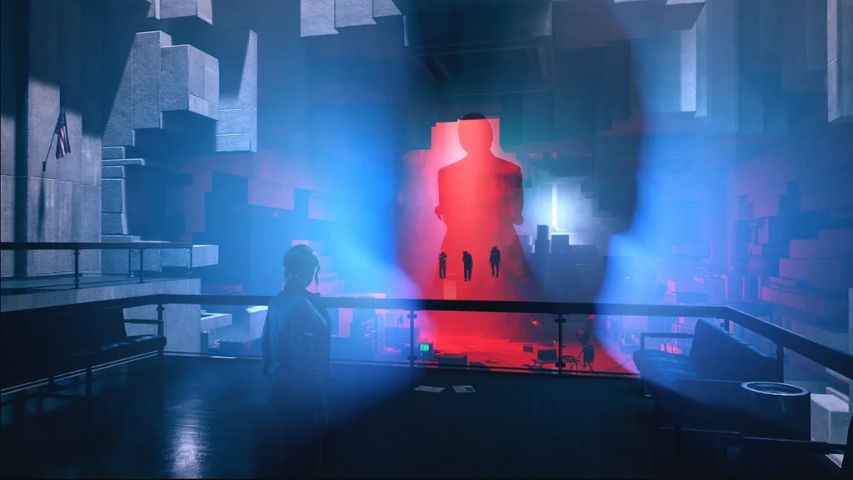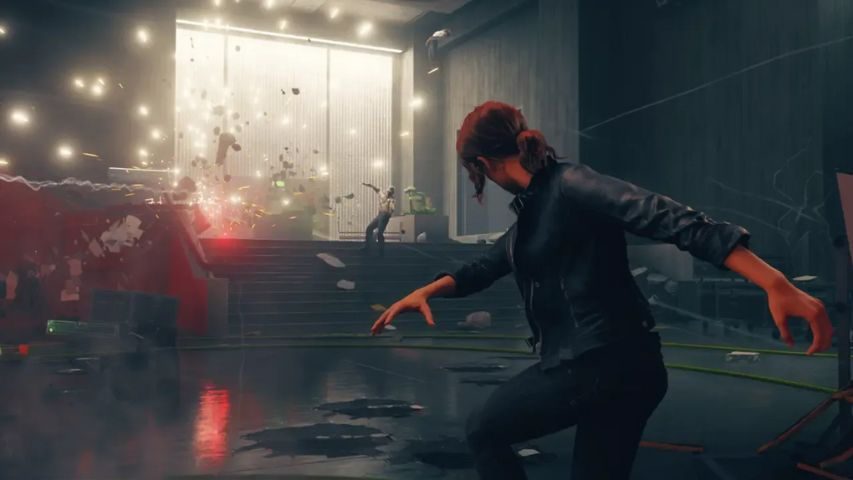
- Developer: Remedy Entertainment
- Publisher: 505 Games
- Genre: Action-Adventure/Science Fiction/Shooter
- Released: August 2019
- Platforms: Windows, Xbos S/X, Xbox One, PS5, PS4, Switch
- Writers: Sam Lake, Anna Megill
Spoiler warning: minor plot details and character discussion for Control, no significant spoilers
Overview
Control is a thrilling third-person action-adventure game that’s deeply rooted in supernatural mystery, governmental conspiracy and a heavy dose of otherworldly weirdness. It’s a fascinating dive into the new weird, challenging players to explore the concept of a hidden reality that exists in plain sight. Control takes the paranormal and puts a metaphorical suit and tie on it, to highly believable effect.
Players expand their psychic abilities and critical thinking whilst navigating the complex realm of the Federal Bureau of Control. This secret government agency is as engaging as the game’s core characters, making the environment feel fresh and challenging no matter how players choose to explore it. Put simply, Control is an amazing game with a wonderfully weird narrative that encompasses all the traits of masterful storytelling.
Personal Context
I first dipped into Control a few years ago. However, I only played it in full recently, when the game’s Ultimate Edition was added to Game Pass. Having now completed the main storyline and both expansions, Control has left a lasting impression. As a lover of single-player adventures, the game resonated with me instantly, but when its X-Files cinematic feel and paranormal combat abilities kicked in, I was completely engrossed.
Key Characters
- Jesse Faden – Control’s protagonist who locates the Federal Bureau of Control at the start of the game, after years of searching for its mysterious headquarters. On arrival, she discovers that all is not as it seems within the Bureau, and an otherworldly chain of events begins to unfold.
- Polaris – A supernatural intelligence, invisible but connected to Jesse’s consciousness, who silently and secretly guides Jesse during the events of the game story.
- Ahti – The janitor of the FBC, and one of the first characters Jesse meets. Ahti’s mystical presence and ability to communicate telepathically with Jesse suggest there’s more to him than meets the eye.
- Director Trench – The Director of the Federal Bureau of Control and a man with a wealth of dark secrets. After he and Jesse cross paths early in the game, he regularly appears to guide and inform her as she explores her new surroundings.
- The Board – A paranatural organisation of deity-like beings, devoid of bodily presence but able to broadcast messages to the FBC Director from another plane of reality.
- Emily Pope – A research specialist in the FBC who becomes one of Jesse’s key advisors during the events of Control.
Jesse encounters several telepathic messages throughout her journey into the Bureau, some from beyond the realm of our known reality.

Gameplay
Control is an action-adventure game played from a third-person perspective. Players step into the role of protagonist Jesse Faden as she’s drawn towards the Federal Bureau of Control in New York, later revealed to be The Oldest House. This seemingly innocuous Brutalist tower block is a place of enormous paranormal power and contains infinite realms that defy the laws of time, space and reality.
During the game, players acquire and develop a variety of psychic combat abilities alongside a core ranged weapon mechanic. In particular, the physics-based telekenetic ability to lift, pull and push items and chunks of building matter feels fresh, powerful and extremely useful in a variety of situations. The Service Weapon is Jesse’s main gun, but this too is a paranatural piece of equipment, capable of shifting forms and undergoing modifications and upgrades for different effects. Combined with Jesse’s abilities for telekenisis, levitation and mental manipulation, this combat skillset is very enjoyable, authentic and satisfying to master.
There’s a metroidvania-style aspect to Control’s design, thanks to the Bureau’s interconnected and seemingly endless internal world of departments, corridors, and subterranean and astral realms. Parts of the Bureau are only accessible after completing certain missions or by collecting specific Objects of Power. These otherworldly objects can grant Jesse additional abilities and skills, further enhancing progression and exploration.
What I like about the game narrative
There’s a lot to love about Control’s narrative. I think it’s one of the first action-adventure games I’ve played in a long time that has a genuinely unique game narrative concept. The game’s weird, supernatural worldbuilding and backstory are woven and concealed so cleverly under blocks of bureaucracy, which is highly unsettling in itself. This makes it a real curious joy to unpick as you explore The Oldest House in an exciting, non-linear manner.
Control is a masterclass in delivering game narrative through environmental storytelling, which for me, is one of the most effective ways to engage players in the wider story of an adventure. The concept’s covert principles are rooted so deeply into every aspect of this game, even so far as its own storytelling. It’s down to the player to discover the history, anomalies, people, events and creepy secrets hidden within the walls of The Oldest House, many of which are hiding in plain sight.
The idea of exploring extended dimensions of reality within a concrete, seemingly nondescript setting really fascinated me. I’m very drawn to the idea of finding the extra in an ordinary setting or world anyway, so telling the story of Control within a building like The Oldest House makes perfect sense. I also loved the character-centric approach to the narrative’s exploration. Jesse’s gradual discoveries about the Bureau and her role within the organisation keep you hooked on the game’s puzzles and problems as you piece everything together alongside her. It all feels very exploratory and environmental, despite being a linear narrative overall.
The seamless interlinking of gameplay mechanics and narrative purpose is another thing Control excels at. Jesse’s powers come alongside a gradual yet believable grasp of new knowledge; every time she grasps a new skill or Object of Power, we learn something more about the bureau, the building, or Jesse herself. It’s incredibly clever and feels authentic to her character development throughout the story.
Also, there’s so much cool, new weird, X-Files-style wider storytelling underpinning the game that you feel as though you’ve barely scratched the surface, even on completion. I love that.
What I’d perhaps do differently
There’s not a lot to say here – I really loved everything about Control. However, if I were to adapt anything, it might be the dialogue options available to Jesse during her interactions with NPCs. I wouldn’t want to add anything that could create a branching narrative, as it’s clear that Control’s linear storyline works perfectly well. However, it might’ve been nice to have a few different response options for when Jesse is conversing with key characters such as Emily Pope or Ahti, for example. Those interactions do end up feeling a bit one-sided, but perhaps that’s the point.
Exploring the game’s building blocks
I find it helpful to examine the game’s core components to see how they work together to communicate the overall narrative experience alongside gameplay.
- Story – The game presents a secretive and supernatural narrative premise from the outset. Storytelling maintains an undercurrent of unease that sits perfectly within the brutalist confines of The Oldest House and its bureaucratic environment. Thanks to frequent bursts of narration from Jesse, a sense of inner monologue really connects with you as a player and lends further weight to the conspiratorial vibe of the story. We get to hear her innermost thoughts as she explores the building and meets those hidden within. This method of thinking aloud makes the player fantasy of being Jesse feel tangible; she’s discovering thrilling and terrifying secrets at the same time as you. It’s all very believable, despite being entirely supernatural, which is what makes the storytelling throughout Control so effective. The combination of a credible environmental narrative at every turn and a player character that unknowingly cuts through the fourth wall with their thoughts is fascinating. We learn more about Jesse’s motivation for finding the Bureau through many of these internal interactions between herself and Polaris, as well as through the game’s environmental clues.
- Mechanics – Jesse’s development and use of paranatural powers feels fresh and inventive. Her abilities take inspiration from the brutalist design of The Oldest House – launching geometric chunks of rubble through the air and body-slamming enemies from above; none of it is gentle or ladylike and it feels incredibly satisfying as a result. Control’s Metroidvania-like exploration also lends itself well to these combat and utility mechanics. Levitation makes traversal of seemingly inacessable areas possible, adding further to the overall vibe that the rules don’t apply here. In a building that’s presented as the very model of organisation, laws and control, what can happen inside is lawless, free from the constraints of physical and natural norms. It’s a brilliant contrast and a clever example of how appearances are often entirely deceptive. The game’s area maps and general level design are a masterclass in invention and using narrative to propel players through an environment that feels living and breathing in its own right. The game’s Ashtray Maze area, in particular, is a feat of technical skill and combat design that has to be experienced to be fully appreciated. It’s probably one of the strongest examples of how the game environment manipulates Jesse, and how she must use her skills and abilities to outwit and survive the world she’s trying to explore.

Jesse’s paranatural abilities feel really satisfying to use and add further credibility to the setting. Ripping chunks of concrete out of walls and launching them telepathically? Extremely enjoyable.
- Aesthetics – The game’s architecture speaks volumes as to the underlying themes in this game. Paranoia, conspiracy, and secrets hidden in plain sight; all things that viably feel at home within a highly secure governmental department building. The Oldest House looks polished and presentable on the surface, with its grey-hued granite and shining black marble deftly communicating a world that means serious business, without giving any of the details away to those without clearance. The cold palette of The Oldest House’s 1960s-style outward design contrasts smartly with the interspersion of bold red tones for the game’s supernatural elements. It communicates the hidden dangers that lurk under even the shiniest, most professional of facades. The aesthetics of the building and its experimental, laboratory-like departments further communicate that insidious forces are lurking beneath the surface of all things, and that they can only be contained for so long. Some things should be left undisturbed, as players learn the deeper they dive into the reddish-black depths of Control.
- Technology – Control’s third-person action-adventure mechanics put a fresh spin on player exploration. The use of technology for motion and combat here feels modern and exciting, making traversal through space feel satisfyingly different. The game’s innovative implementation of puzzles is another area of excellence, demonstrating the team’s commitment to developing weird experiences for Jesse to unpick as she makes sense of her surroundings and puts the pieces of her personal story back together. Control also has some fantastic technical moments of transmedia storytelling, where the player experiences cinematic interruptions and overlays without stopping the flow of gameplay. It just all looks and feels highly unique and conspiratiorial, making spookiness feel tangible through audio cues and visual engrossement. It’s unbelievably clever, in a nutshell.
Aspects of the game I’d want To Implement In My own Work
- Non-linear exploration and a metroidvania format of map and level design that complements and enhances the game’s narrative elements.
- Impactful environmental storytelling and an array of readable and audiovisual collectables that make The Oldest House feel like another character.
- Supernatural elements that lean into the believable. These otherworldly events, characters and items remain firmly rooted in our reality, which makes them even creepier.
- Sci-Fi that makes sense in the real world. Relatable weirdness, for want of a better description.
- Cinematic cutscenes and overlays that merge in amongst sections of exploration and gameplay, blurring the lines between the mediums of game and television. They make the narrative feel richer and more dynamic.
- Wide worldbuilding through discoverable case files, documentation and secrets, enhancing the conspiratorial premise and making the environment a highly compelling place to explore.
- Character-centric central thread with a main character that uses stream-of-consciousness narration in an engaging and non-cliche manner.
- Physics-based combat and motion that feels in-keeping with the new weird themes and blocky, maze-like location for the game story.
- Clean UI design with an engaging approach to map and documentation presentation.
- Highly engaging soundscape and audio effects, making use of music in a very considered and purposeful way to enhance certain aspects of gameplay.
Summary
If I had to summarise this game in one word, it’d be “innovative”. That feels like a bit of a disservice, though. Control is one of those rare games that makes the action-adventure genre feel new and meaningful again. The narrative is so enriched with the possibilities that alternate realities could bring, yet it remains rooted in a believable cognitive space. It’s a thrilling and often strange experience that doesn’t veer into complete horror, although there are decidedly spooky moments that may prove unsettling to some players. For me, it struck a perfect balance of sci-fi creepiness and a very human, television-flavoured drama, wrapped up with powerful combat abilities that complement Jesse’s newfound movement skills.
Discovering the secrets and some of the history of The Oldest House reveals how important worldbuilding through environmental story can be. There are no chunks of exposition; you learn as you go, just as Jesse does. The more you uncover, the more compelled you are to dive deeper into the world of Control, giving pause to think about the depths of dark secrets simmering under bureaucratic red tape. The contrast of conspiratiorial science fiction and supernatural worry works so well here, as if two sides of the same mystical coin.
I could go on, but this is a game I feel that everyone should play, and that game designers and writers can learn a lot from. It’s fantastic and is a great example of how games and more traditional media can intersect in a powerful way.